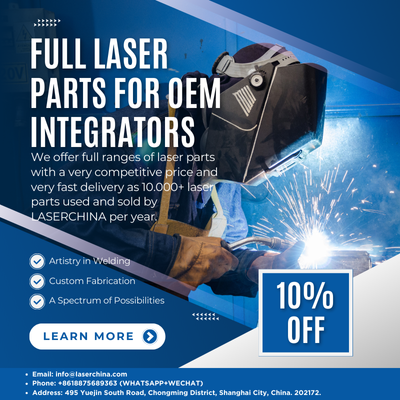Handheld laser welders have gained popularity due to their portability, ease of use, and precision in welding various metals. These machines are used in industries ranging from automotive repair to metal fabrication, as they allow for high-quality welds without the need for heavy, stationary equipment. However, the price of a handheld laser welder can vary widely depending on several factors. Understanding these factors is essential when considering a purchase, as the price should reflect the machine’s capabilities, features, and intended application.
1. Price Range for Handheld Laser Welders
The price of a handheld laser welder can typically range from $5,000 to $50,000 or more, depending on the machine's features, brand, and capabilities. Here’s a more detailed breakdown of what you might expect:
-
Entry-Level Machines: These are usually priced between $5,000 and $15,000. These models are best suited for small-scale operations or businesses that need a portable, basic solution for welding thinner materials. They generally have lower power outputs (typically 100W to 500W) and fewer advanced features, but still offer decent quality and precision for light welding tasks.
-
Mid-Range Machines: Priced between $15,000 and $30,000, these machines offer better performance and can handle a wider range of materials and thicknesses. With higher power output (around 500W to 1kW), these models are suitable for medium-sized businesses or more demanding welding applications. They often include advanced features like better cooling systems, enhanced user interfaces, and some level of automation.
-
High-End Machines: The most advanced handheld laser welders can cost $30,000 to $50,000 or more. These machines typically have power outputs of 1kW or higher and are designed for heavy-duty industrial use. They come with top-tier features, such as automatic pulse modulation, superior cooling systems, high precision, and the ability to weld a wide range of materials, including thick metals. They are ideal for businesses that require consistent, high-quality welds for large-scale production.
2. Factors Influencing the Price of a Handheld Laser Welder
Several key factors influence the price of a handheld laser welder. These include:
a. Power Output
The power output of the laser is one of the most significant factors in determining the price. Higher power lasers can weld thicker materials and produce deeper, more robust welds. For example, machines with a power output of 500W or lower may cost less, while those with outputs of 1kW or higher are generally more expensive due to their increased welding capacity and versatility.
b. Laser Type
There are different types of lasers used in welding, and their choice impacts the price:
-
Fiber Lasers: These lasers are commonly used in handheld welders due to their efficiency, precision, and low maintenance. Fiber laser welders are typically more expensive than CO2 laser welders, but they provide better results for most materials and are more energy-efficient.
-
CO2 Lasers: Although less common in handheld units, CO2 lasers can be less expensive than fiber lasers but tend to have higher maintenance costs and lower overall efficiency.
c. Brand and Build Quality
The brand and build quality of the machine play a significant role in pricing. Well-established brands with a reputation for reliability and customer service, such as Trumpf, IPG Photonics, or Han’s Laser, often command a higher price due to their advanced technology, extensive warranties, and support services. On the other hand, lesser-known or budget brands may offer lower prices but could come with fewer guarantees or support options.
d. Cooling System
Laser welding machines generate a lot of heat, and a reliable cooling system is essential to maintain performance and prevent overheating. Handheld laser welders typically use either air-cooled or water-cooled systems. Water-cooled systems tend to be more expensive because they are more efficient and better suited for high-power applications, while air-cooled systems are less expensive and suitable for light or intermittent use.
e. Portability and Ergonomics
Handheld welders are valued for their portability, but this can also affect the price. Machines that are lightweight, easy to handle, and feature ergonomic designs may cost more due to the engineering required to make them portable without sacrificing performance. Additionally, welders with features such as adjustable handles, comfortable grips, and well-balanced designs often come with a higher price tag.
f. Advanced Features and Automation
Modern handheld laser welders may come with additional features that enhance their ease of use and welding quality. These can include:
-
Auto-Focus: Some machines have automatic focusing systems that adjust the beam for different materials or thicknesses, improving precision.
-
Pulse Control: Advanced pulse modulation helps control the heat input, providing more consistent welds, especially on thin or delicate materials.
-
Touchscreen Interfaces: User-friendly control systems with intuitive interfaces and digital displays may increase the price, but they improve usability and allow operators to easily adjust welding parameters.
g. After-Sales Support and Warranty
Warranties and after-sales support can also influence the price. Handheld laser welders with longer warranties and more comprehensive customer service options tend to be more expensive, as they offer peace of mind and protect the investment in the long run. Access to training, installation assistance, and local service providers is crucial for minimizing downtime and ensuring the machine runs optimally.
Conclusion
When evaluating the price of a handheld laser welder, it is crucial to balance the machine’s features with your specific welding needs. Entry-level models are suitable for lighter tasks and small businesses, while mid-range and high-end machines offer greater versatility and higher performance for more demanding applications. Always consider the power output, cooling system, brand reputation, and advanced features when assessing the overall value. While the initial investment can be significant, the speed, precision, and low maintenance costs of handheld laser welders make them a cost-effective choice in the long run for many industries.




